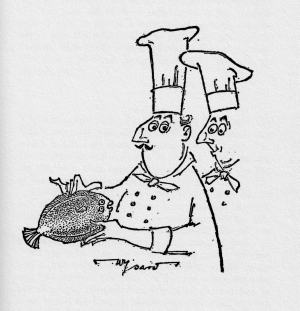An Appreciation of Wheelers
Past if not present, and literary as well as culinary
Once upon a time in the West End of London there was Wheeler’s, a chain of fish restaurants dating, they said, to 1856, but it seems the founding reference was to a fishmonger instead. The original restaurant incarnation of the brand stood in or on Old Compton Street depending on your usage but the best was tucked away down a narrow passage of St. James’s. Three decades ago its racing green façade and diagonal leaded panes beckoned diners like the lone beacon that it was. Wheeler’s looked retardataire during this butt of a revivalene era in mainstream Britain but, at its best, the food did not suffer for that.
You never should have accepted any innovation, however lacking in conviction, that you might find there, and should never have ventured beyond the St. James’s outpost. Other branches, like the one in Chelsea, lacked the ambience and kitchen at St. James’s, and only the rash masochist would tempt the maenads by ordering a sauce or stew at Wheeler’s, for that road brought ruin in the form of glue or string.
A staffer at britishfoodinamerica once ignored these facts in the presence of one Blanton Eishor, a self-styled Francophile who knew no French despite pretending. He was a diner who never cooked and lawyer who knew no law. Readers will know the type, neither so despicable as DeSelby nor an admirable figure, the kind of person who laughed at his own incessant jokes, always offered at the expense of others. In culinary terms Blant, as he then was known, prefigured our digital age in his binary outlook; French food good, English food bad.
Our staffer would show him. She would take him to Wheeler’s and gloat as he sacrificed ideology to the moment, for Blant may have been epicurian in aspiration but certainly was gluttonous at heart. He would lose all pretense and control to tuck into simply, which equates to perfectly, prepared paragons from Britain’s brisk northern seas.

At table, however, tables were turned. The ill-matched pair dined in the gaudy and yet gloomy cellar of the Chelsea branch with its textured red flock and expanse of random seating. Blant ordered something Mornay that really belonged to Elmer and the staffer found herself confronting some cremated fish smeared with Mayonnaise and escorted by wan shrivelings of bell pepper. So much for a cautionary tale.
Back in St. James’s, the oyster bar stood inches inside the doorway at ninety degrees, along a narrow passage decorated with the usual pictures screwed by brass into walnut paneling. This was either cramped or cozy depending on your perspective: The Editor always found the glass half full. This also was better than the dining room, especially if, due to unfortunate business requirements or an abrupt change of itinerary, you dined alone.
The staff behind the bar was neither friendly nor brusque, but rather respectful and efficient. Their objective was neither making friends nor mocking the friendless, and this was a welcome vestige, since lost, of something comforting and English. They served pristine oysters with Black Velvet; the luxury did not seem expensive. The cod, plaice and sole were fresh; the Chablis bracing and decent.
Plaice remains a favorite of the Editor. It is considered a coarser food than its flatfish cousins, perhaps a little embarrassing; we find it robust instead, and wish that it swam in North American waters. Back in London back in the day, the Editor once encountered a most attractive woman of a certain age at Wheeler’s, one of those tall English blondes, who confided that at times she needed to discard propriety to tear vampirically (Updike would say, and has said, ‘like a ravening she-wolf,’ but that simile belongs in context to an altogether different species of appetite) into a ‘whole piggy plaice’ instead of something more discrete. The Editor herself has sufficient discretion to withhold further detail about the conversation.
Wheeler’s produced not only agreeable food and company, but also a rather serviceable cookbook, in 1974, and something out of the ordinary for a restaurant, its quarterly journal. It therefore is altogether fitting that the cookbook’s publisher, Michael Joseph, carried a bookish mermaid as its logo at the time.

Wheeler’s Review lasted for almost three decades, from 1955 until 1984. Its subject, rather liberally defined in retrospect, was matters culinary. Pat Davis, the Review’s last editor, wrote in the 1986 compilation of essays from the quarterly, that “[i]t was a subtle brainwave, the softest of cultured soft sells, that was to turn advertising into art and to be eagerly welcomed in over 100 countries.” (Oysters & Champagne: Choice Morsels from Wheeler’s Review, London 1986, 11) It also was the literary playground for the subversive element of a certain Old School elite, mostly British but also including the likes of Leonard Bernstein. An Ascendancy aristo, wrote for the Review, along with a baron, a brigadier, a countess, a major general and the author of Whisky Galore, which subsequently was filmed as such in Britain and then released in the United States as Tight Little Island.
So, for example, Joan Oliphant-Fraser writes candidly in 1967 that there “are occasions, when besides looking like a sex bomb, we want to look intelligent as well. This can be achieved by discreetly (providing the type is big enough) carrying a copy of Das Kapital” or alternatively by becoming “an oenologist, a baccanalian nymph, a student of wine.” (Oysters 40) Sir George Bellew weighs in with an equally useful “inquiry into the significance of seafood in heraldry, with a special reference, ‘that democracy may be preserved,’ to the ‘socially less fortunate fish.’” (Oysters 97) To preface his “Meals to Remember, some tales of the long fork, ” D.B. Wyndham Lewis wrote in his ‘Self-assessment’ that he was
“Author, journalist, and (at full moon) critic. Fellow, for some reason, of the Royal Society of Literature. Columnist for some years in the London Daily Express, Daily Mail, News Chronicle, and Tatler. Has even made the New Yorker, and, before they tightened things up, had a photograph in Time. Also writes books, but who doesn’t? Favourably spoken of in the trade for integrity, though not often.” (Oysters 171)
Despite all this, the Review included (on occasion) some good recipes. Heavy, heavy and delightful classics like Lobsters Newberg and Thermidor, if American to their cores, make an appearance courtesy of Carole Walsh, whose recipes remain useful, rich and timeless. A page away (in the anthology), Sole Pommery sauces the fish with apple, chutney and lemon in a mélange that could be neither less French nor more English.
Back onshore, James Robertson-Justice (“a career undistinguished but varied, some three score jobs in different parts of the world”) adds a startling (for Wheeler’s) innovation, the service of woodcock, “not, as usual, on toast, but on crumpets, a discovery which,” he says, “I am proud to have made in the interests of gastronomy.” (Oysters 153, 154) ‘Old Compton,’ the journal’s nom de plum’d editor and bon vivant, offers a recipe for braised pheasant that involves bacon, cabbage, chestnuts, smoked sausage and thyme: We need say nothing more, unless readers demand it. Further examples of fearless recipes for pheasant may or may not appear in future numbers.
As an aside, however, it may be useful to note that ‘Old Compton’ was in fact any of several staff writers enlisted variously to lend the Review a sliver of consistency, and the name of course refers to the location of the first Wheeler’s.
This Appreciation may serve, however momentarily, as our unacceptably nostalgic restaurant review for this number of britishfoodinamerica, but as for Wheeler’s itself we would not recommend Marco Pierre White’s deracinated reincarnation of the old fishy flame.
Editor’s note: The quoted fictive passage, from The Widows of Eastwick, was instrumental in earning Mr. Updike the first Bad Sex Prize Lifetime Achievement Award from the Literary Review in 2008. The Award, alas, was posthumous: Poor John.

